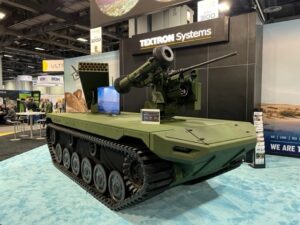After providing its Ripsaw robotic platform to the Army for experimentation, Textron Systems [TXT] is looking to offer a new swim-capable, smaller version of the system for the Army’s expected upcoming Robotic Combat Vehicle-Light (RCV-L) competition.
Textron showcased a concept demonstrator of the new Ripsaw M3 at this week’s Association of the United States Army’s (AUSA) annual conference in Washington, D.C, with a company official highlighting the platform’s modularity and design considerations for potential RCV-L requirements.

“It’s intended for us to kind of get ahead of any requirements that might come out when the Army releases their capabilities development document for the [RCV]-L,” David Phillips, Textron’s senior vice president of land and sea systems, told Defense Daily during an interview at the AUSA conference.
The Army in January 2020 selected Textron and its team of Howe & Howe and FLIR [FLIR] to deliver the larger Ripsaw M5 as a prototype for evaluation of an RCV-Medium.
At the same time, the Army awarded an RCV-L prototype deal to QinetiQ and Oshkosh Defense’s [OSK] Pratt Miller to deliver four vehicles for experimental testing based on a variant of the Expeditionary Modular Autonomous Vehicle (Defense Daily, Jan. 9).
Phillips noted Textron delivered four Ripsaw M5s to the Army for recent soldier operational testing, as well as an all-electric version for the Army’s Combat Capabilities Development Center to work on armament lethality payloads.
“We got good feedback from the soldiers. A lot of that was very helpful as we’re kind of thinking of the next product in the Ripsaw family,” Phillips said.
Doug Bush, the Army’s top acquisition official, confirmed in July the Army plans to move ahead for now with a focus on developing the light variant, the RCV-L (Defense Daily, Aug. 3).
“Right now, the Army only has one funded [prototype] program and it’s the Light. That’s not to say the Medium won’t eventually happen. I think they’re focusing in on the Light version and coming up with those requirements,” Phillips said. “We believe they’re going to come out with an RFP and they’re going to have a pretty quick turn for vendors to deliver bid samples that they’re then going to test. So we can’t have long development timelines. We can’t have long supply chain timelines. We wanted to go ahead and get all of that out of the way, so we can flex if we have to flex based upon their requirements.”
Phillips noted a key difference from the Ripsaw M5 is the new M3 concept demonstrator’s swim and submersion capability, with water jet propulsors on the back of the platform.
“It’s really intended to cross a wet gap. What happens to a robot that’s supposed to be out in front of the force collecting situational awareness and now it gets to a water boundary and it can’t cross it. Although [the Army] hasn’t defined it yet, I think at some point they’ll want to have it upgradeable to that or kitted to that or have it be a native swim capability,” Phillips said. “And why submersion? We like to test on the edges here, kind of extreme testing. So that’s propelling on the bottom of the ocean, actually have submerged it and let it sit for seven days and then come call it back up with 96 percent of its battery power.”
The Ripsaw M3 is also designed to be transportable inside of a CH-47 Chinook helicopter and designed with a hybrid-electric drive with a combustion engine component Phillips described as “smaller, more commercial, less specialized.”
Phillips noted the Ripsaw M3 also features capability for 14 inches of ground clearance, which he cited as a lesson pulled from the Army’s recent soldier operational experiments with robotic vehicles.
“It has to be mobile. It has to be able to go to the same places that Bradley’s go,” Phillips said.
To highlight the Ripsaw M3’s modularity, Textron showcased different payloads on the concept demonstrators during each day of the conference, ranging from remote weapon stations to an Air-Launched Effects launcher.
“[The Army] basically can put any payload on that fits within the weight and space requirements of this system,” Phillips said.